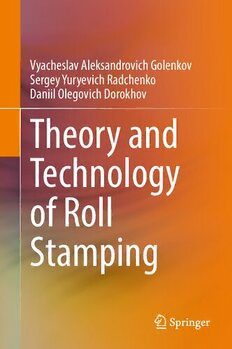Table Of ContentVyacheslav Aleksandrovich Golenkov
Sergey Yuryevich Radchenko
Daniil Olegovich Dorokhov
Theory and
Technology
of Roll
Stamping
Theory and Technology of Roll Stamping
·
Vyacheslav Aleksandrovich Golenkov
·
Sergey Yuryevich Radchenko
Daniil Olegovich Dorokhov
Theory and Technology
of Roll Stamping
VyacheslavAleksandrovichGolenkov SergeyYuryevichRadchenko
OrelStateUniversitynamedafterI.S. OrelStateUniversitynamedafterI.S.
Turgenev Turgenev
Orel,TheOryolArea,Russia Orel,TheOryolArea,Russia
DaniilOlegovichDorokhov
OrelStateUniversitynamedafterI.S.
Turgenev
Orel,TheOryolArea,Russia
ISBN978-3-030-91816-3 ISBN978-3-030-91817-0 (eBook)
https://doi.org/10.1007/978-3-030-91817-0
TranslationfromtheRussianlanguageedition:Teori(cid:2)itehnologi(cid:2)valkovo(cid:3)xtampovki©
Oru(cid:4)ieitehnologii2019.PublishedbyOru(cid:4)ieitehnologii.AllRightsReserved.
©TheEditor(s)(ifapplicable)andTheAuthor(s),underexclusivelicensetoSpringerNature
SwitzerlandAG2022
Thisworkissubjecttocopyright.AllrightsaresolelyandexclusivelylicensedbythePublisher,whether
thewholeorpartofthematerialisconcerned,specificallytherightsofreprinting,reuseofillustrations,
recitation,broadcasting,reproductiononmicrofilmsorinanyotherphysicalway,andtransmissionor
informationstorageandretrieval,electronicadaptation,computersoftware,orbysimilarordissimilar
methodologynowknownorhereafterdeveloped.
Theuseofgeneraldescriptivenames,registerednames,trademarks,servicemarks,etc.inthispublication
doesnotimply,evenintheabsenceofaspecificstatement,thatsuchnamesareexemptfromtherelevant
protectivelawsandregulationsandthereforefreeforgeneraluse.
Thepublisher,theauthorsandtheeditorsaresafetoassumethattheadviceandinformationinthisbook
arebelievedtobetrueandaccurateatthedateofpublication.Neitherthepublishernortheauthorsor
theeditorsgiveawarranty,expressedorimplied,withrespecttothematerialcontainedhereinorforany
errorsoromissionsthatmayhavebeenmade.Thepublisherremainsneutralwithregardtojurisdictional
claimsinpublishedmapsandinstitutionalaffiliations.
ThisSpringerimprintispublishedbytheregisteredcompanySpringerNatureSwitzerlandAG
Theregisteredcompanyaddressis:Gewerbestrasse11,6330Cham,Switzerland
Introduction
Production of competitive equipment for various purposes requires parts with
highmechanicalandphysicalproperties,technologicallysimpleinproductionand
economicallyfeasible.
Fundamentally,newmetalformingprocessesincludeatechnologywithcomplex
local loading of the workpiece plastic deformation zone, which simultaneously
combinesbulkstampingandlocaldeformationofthedeformationzonebyspinning
rollersordrivenrolls,called“rollstamping.”
Themainobjectiveofdevelopinganewmethodandcorrespondingtechnology
istoprovidecontrolovertheplasticdeformationprocessandobtainproductswith
predeterminedtechnologicalandphysicalproperties.Rollstampingallowstosignifi-
cantlyreducethedeformationforce,increasethetoolservicelife,increasesthemetal
utilizationrate,reduceorcompletelyeliminatetheneedforsubsequentmachining,
anddecreasemetalandenergyconsumptionofequipment.
Oneoftheimportantadvantagesofthenewproductionprocessisthecontrolled
gradient hardening of the subsurface layers of the product due to periodic local
loadingofthedeformationzonewiththesimultaneousapplicationofaglobalmono-
tonicload.Thisallowstoformsubmicro-andnanostructuresgradientstartingfrom
theoutersurface,whilethevaluesanddistributionofmechanicalpropertiesoverthe
volumeoftheproductcanbeplannedinadvance.
The existing techniques for calculating local deformation processes, as well as
techniques for calculating traditional bulk stamping methods with a fixed region
of deforming force application (pressing, extrusion, upsetting, etc.), do not allow
calculatingtheprocessesofrollstampingwithasufficientaccuracy.Thismonograph
discussestherollstampingtheorybasics,researchofproductionprocesses,aswell
asmethodsfortheirdesign.
The following researchers from the Oryol State University named after I. S.
Turgenev took part in the preparation of the materials for this publication: P. G.
Morev,K.I.Kapyrin,G.P.Korotky,T.V.Fedorov,I.M.Gryadunov.
v
Contents
1 AnalysisofMethods fortheProduction ofAxisymmetric
PartswithGivenSpecifications ................................. 1
1.1 Workpiece Forming Methods and Their Effects
ontheMechanicalandPhysicalPropertiesofMetals .......... 1
1.2 ClassificationofRollStampingProcesses .................... 9
1.3 HardeningbyMetalFormingMethods ...................... 12
References .................................................... 22
2 DevelopmentoftheCalculationProcedureforProduction
ProcessesofMetalForming .................................... 29
2.1 TraditionalMethodsofMetalFormingProcessCalculation ..... 29
2.2 MathematicalProblemDefinitionforMetalForming .......... 31
2.3 Solving Problems of Elastoplastic Deformation
bytheFiniteElementMethod .............................. 33
2.3.1 CalculationofTemperatureFields ................... 33
2.3.2 Calculation of Displacements, Deformations
andStresses ...................................... 36
2.4 AccuracyEstimationAlgorithms ........................... 37
2.4.1 ResultsAccuracyEstimation ....................... 37
2.4.2 PosteriorEstimatesBasedontheDualityMethod ..... 37
2.4.3 PosteriorEstimatesBasedonCalculationsUsing
GridsofDifferentDensities ........................ 42
2.5 DefiningaFiniteElementGrid ............................. 46
2.6 MainAspectsoftheNumericalSolutionofMFProblems ...... 48
2.7 Analysis of Elastoplastic Models Using Dedicated
SoftwarePackages ....................................... 54
References .................................................... 54
3 RollStampingofLongBarStock ............................... 57
3.1 AnalysisoftheStress–StrainStateDuringRollStamping
ofaStrand-ShapedWorkpiece ............................. 57
3.2 ExperimentalStudiesofRollStampingofLongBarStock ..... 63
vii
viii Contents
3.3 LongBarStockRollStampingProcessRefinement ........... 77
References .................................................... 82
4 RollStampingofPieceBlanks .................................. 85
4.1 MetalFlowSpecificsDuringRollStamping .................. 85
4.2 NeutralCross-sectionalAngleandRollStampingProcess
Kinematics .............................................. 88
4.3 ConditionsandSpecificsofWorkpieceAxialTightening
DuringRollStamping ..................................... 91
References .................................................... 94
5 ForceParametersofRollStamping ............................. 95
5.1 RollStampingStages,AnalysisofChangesinWorking
load, and Factors Affecting the Force Parameters
oftheDeformationProcess ................................ 95
5.2 Influence of the Relative Deformation Rate
ontheWorkpieceRotationCondition ....................... 100
References .................................................... 102
6 MathematicalModelingofRollStamping ....................... 103
6.1 MainObjectivesandSolutionMethods ...................... 103
6.2 TheProcedureforCalculatingToolLoadsDuringRoll
Stamping ............................................... 104
6.3 CalculationofRollStampingProcessParametersDuring
thePiercingStage ........................................ 104
6.4 CalculationofRollStampingProcessParametersatRoll
BurnishingStage ......................................... 115
6.5 StressandDeformationDistributionintheWorkpiece
CrossSectionattheRollBurnishingStage ................... 128
6.6 CalculationoftheRollerForceandContactStress,Punch
Force,RequiredandCreatedMoments ...................... 130
6.7 MethodologyforCalculatingtheMaximumPermissible
RelativeWorkpieceDeformationRate ....................... 140
6.8 DistributionofNormalStressesontheToolDuringRoll
Stamping ............................................... 142
References .................................................... 147
7 MainProductionProcessesofRollStamping .................... 149
Reference ..................................................... 157
8 LocalStrainHardening ........................................ 159
8.1 ProblemDefinition ....................................... 159
8.2 CalculationofKinematicandForceParametersofRoll
Burnishing .............................................. 160
8.3 MathematicalModelingofRollBurnishing .................. 168
8.4 ExperimentalStudiesofRollBurnishing .................... 173
References .................................................... 175
Contents ix
9 HardeningbyComplexLocalDeformation ...................... 177
9.1 RollBurnishingwithBrakingTorque ....................... 177
9.1.1 The Effect of the Braking Force Applied
totheRollerontheDeformationRate ............... 178
9.1.2 Multi-cycleRollBurnishing ........................ 183
9.2 RollBurnishingwithFormingandSmoothingTools ........... 192
9.3 Analysis of the Results of Study of the Forming Tool
ShapeandGeometryforHardeningbyComplexLocal
LoadingoftheDeformationZone .......................... 201
9.4 MathematicalModelingofComplexLocalDeformation ....... 204
9.5 JustificationofOdqvistParameterastheGenericCriterion
for Comparing Physical and Mathematical Modeling
Results ................................................. 214
9.6 Influence of the Forming Tool Geometry and Its
Indentation Depth on the Stress–Strain State
oftheWorkpieceinaSingleActofDeformation .............. 220
9.7 InfluenceofAxialCompressionontheStress–StrainState
oftheWorkpieceDuringHardeningbyComplexLocal
LoadingoftheDeformationZone .......................... 233
9.8 Study of the Influence of Process Conditions
ontheProcessesofHardeningbyComplexLocalLoading
oftheDeformationZone .................................. 241
References .................................................... 254
10 ComplexLocalDeformationProcessesandMethodsofTheir
Design ....................................................... 259
10.1 ClassificationofComplexLocalDeformationProcesses ....... 259
10.2 Workflow Processes of Complex Local Deformation
byRollBurnishing ....................................... 262
10.3 Methodology for Designing MF Methods Based
onComplexLocalLoadingoftheDeformationZone .......... 270
10.3.1 Determining Parameters of Roll Burnishing
withBrakingTorque .............................. 270
10.4 MethodologyforDesigningRollBurnishingProcesses
withFormingandSmoothingToolsUsingtheOdqvist
Parameter ............................................... 275
10.4.1 Problem Definition for Design of Metal
FormingProcesseswithComplexLocalLoading
oftheDeformationZone,AllowingFormation
of Gradient-Hardened Structures in Metals
andAlloysinaControlledManner .................. 275
x Contents
10.4.2 RecommendationsfortheSelectionofProcess
Parameters in the Design of Metal Forming
Methods with Complex Local Loading
of the Deformation Zone, Allowing Forming
Gradient-Hardened Structures in Metals
andAlloysinaControlledManner .................. 278
10.5 NewProcessesofHardeningbyComplexLocalLoading
oftheDeformationZone .................................. 297
10.5.1 TheProcessofHardeningbyComplexLoading
of the Deformation Zone to Obtain Various
Mechanical Properties Along the Workpiece
Length .......................................... 297
10.5.2 TheProcessofHardeningbyComplexLoading
of the Deformation Zone for Forming Using
VariousToolsinaSingleProcessingCycle ........... 298
References .................................................... 299
Chapter 1
Analysis of Methods for the Production
of Axisymmetric Parts with Given
Specifications
1.1 WorkpieceFormingMethodsandTheirEffects
ontheMechanicalandPhysicalPropertiesofMetals
Axisymmetricpartshavingasteppedouterandinnersurface,longbody,externalor
internal thread are widely used due to the most efficient distribution of inner load
stressesandtheminimumamountofmaterialsneededfortheirproduction.
Productionversionselectionisbasedonthepartproductionaccuracy,production
program, design complexity, workpiece and part geometric dimensions, material
composition,capabilitiesoftheavailableequipment,aswellasdegreesofscientific
validity,development,andexperimentaltestingoftheselectedproductionprocess.
Technology selection is mostly based on the final product requirements and its
operationspecifics.
Axisymmetricpartproductiontechnologyincludescuttingandformingprocesses.
Forpartswithhigh-qualityrequirements,cuttinghasthefollowingmaindisadvan-
tages:lowmetalutilizationrate(0.2…0.6),lowperformance,aswellastheinability
toimprovemechanicalandphysicalpropertiesofparts.
While metal forming processes (MF) benefit from work hardening, absence of
cuts,macrostructureimprovement,aswellasmetalutilizationrateincreaseupto0.8
andhigher.ThefollowingmainMFprocessesareutilized[1–3]:
(cid:129)
forging,stampingwithdrophammersandhydraulicpresses;
(cid:129)
hot stamping with hot-stamping crank presses (HSCP) and horizontal forging
machines(HFM);
(cid:129)
bulkcoldstamping;
(cid:129)
cross-wedgeandcross-helicalrolling.
Forging [4, 5] produces high-quality large workpieces for further processing.
Forging is one of the most efficient ways to obtain high-quality workpieces in a
dedicatedproductionandtheonlypossiblewaytoobtainlargeworkpieces.
©TheAuthor(s),underexclusivelicensetoSpringerNatureSwitzerlandAG2022 1
V.A.Golenkovetal.,TheoryandTechnologyofRollStamping,
https://doi.org/10.1007/978-3-030-91817-0_1

